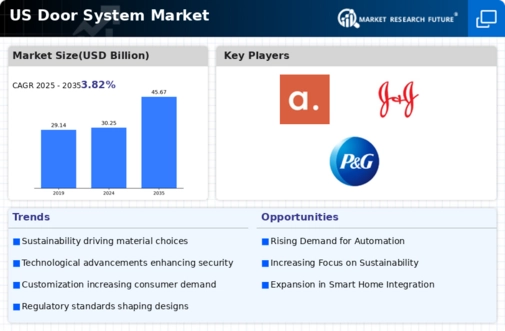Regulatory Standards and Building Codes
The door system market is influenced by evolving regulatory standards and building codes aimed at enhancing safety and energy efficiency. Compliance with these regulations often necessitates the adoption of advanced door systems that meet specific performance criteria. For instance, the International Building Code (IBC) mandates certain fire safety standards for commercial doors, which can drive demand for specialized products. As regulations become more stringent, manufacturers in the door system market must innovate to meet these requirements, potentially leading to increased market growth.
Urbanization and Infrastructure Development
Rapid urbanization in the United States is significantly impacting the door system market. As cities expand and new residential and commercial buildings emerge, the demand for efficient and aesthetically pleasing door systems is increasing. The construction sector is projected to grow at a CAGR of 4.5% through 2026, which will likely boost the door system market. Additionally, urban areas are increasingly focusing on modern designs and functionality, further driving the need for innovative door solutions. This trend suggests a strong correlation between urban development and the growth of the door system market.
Rising Demand for Customizable Door Solutions
Customization is becoming a key driver in the door system market as consumers seek products that reflect their personal style and meet specific functional needs. The ability to tailor door systems in terms of design, materials, and features is increasingly appealing to both residential and commercial buyers. In 2025, the market for customizable door solutions is expected to grow by approximately 20%, suggesting a strong consumer inclination towards personalized products. This trend indicates that manufacturers must adapt their offerings to include a wider range of customizable options to capture this growing segment of the market.
Technological Advancements in Security Features
The door system market is experiencing a notable shift due to advancements in security technology. Enhanced locking mechanisms, biometric access controls, and smart surveillance systems are becoming increasingly prevalent. These innovations not only improve safety but also appeal to consumers seeking modern solutions. In 2025, the market for smart locks alone is projected to reach approximately $1.5 billion, indicating a robust demand for security-enhanced door systems. As consumers prioritize safety, the integration of these technologies into door systems is likely to drive growth in the industry.
Consumer Preferences for Energy-Efficient Solutions
There is a growing trend among consumers in the United States towards energy-efficient door systems. As awareness of environmental issues rises, homeowners and businesses are increasingly seeking products that contribute to energy savings. The door system market is responding to this demand by offering solutions that enhance insulation and reduce energy consumption. In 2025, it is estimated that energy-efficient doors could account for over 30% of the total market share, reflecting a significant shift in consumer preferences. This trend indicates that manufacturers must prioritize energy efficiency in their product offerings to remain competitive.














Leave a Comment